
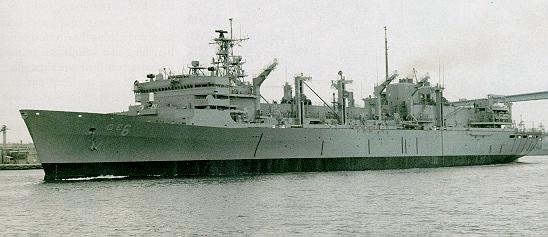
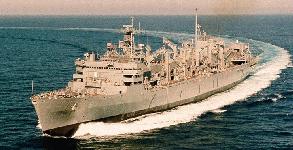
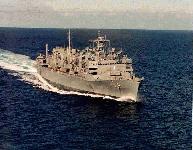
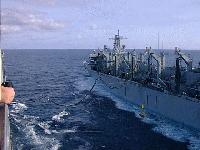
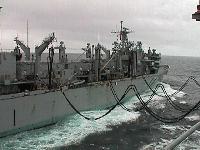
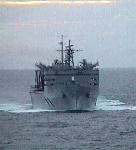
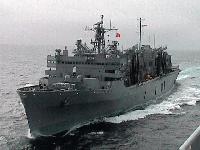
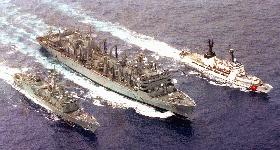
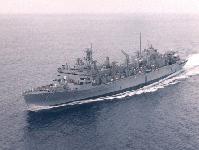
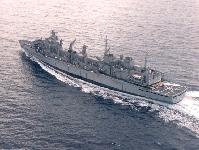
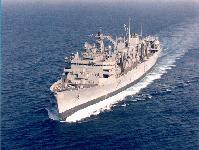
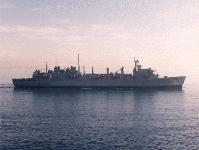
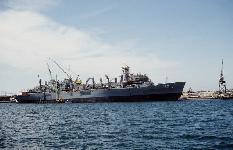




As part of the March 1991 supplemental appropriation bill, the House recommended a provision (section 205) transferring $237,000,000 from the AOE program funded in 1991 to other AOE ships funded in prior years for potential cost overruns. The House report noted that no claims have been agreed upon, but directed the Navy to proceed expeditiously to resolve this matter and complete the ships. The Senate provided no funds because there had no determination of total government liability. Even though govenment liability was estimated at $29,300,000, the Secretary of the Navy supported the transfer as proposed by the House in order that the Navy may proceed expeditiously to complete the ships. The conferees agreed with the provision of the House, noting the Secretary's support. The conferees were concerned that providing funding in advance of any known requirement could be interpreted as a demonstration of congressional intent that this amount represents the government's liability. The conferees emphatically rejected such an interpretation. Further, in order to assure a proper accounting of the government's liability, the conferees directed the General Accounting Office to monitor the resolution of claims in this instance. The Navy was directed not to obligate any of these funds for payment of claims until each specific obligation was determined by GAO to be an appropriate cost to the government.
The 1992 Defense Budget Rescission Conference Report recommended rescissions of $300 million from the AOE Fast Combat Supply Ship. The AOE ship was on deferral by the Secretary of Defense. The agreement left $200 million in the program which was available to be obligated for advance procurement of long-lead material, equipment, and engineering services for the AOE-10. In 1993 the Congress agreed to provide $300,000,000 for the AOE program, as proposed by the House. The amount provided, combined with $200,000,000 of fiscal year 1992 funds for this program, provided sufficient resources to allow for an expeditious award of the AOE-10 ship construction contract.
The fast combat support ship BRIDGE (AOE 10) was christened on 28 March 1998 at National Steel and Shipbuilding in San Diego. The ship is being named for Commodore Horatio Bridge, first leader of the precursor to today's Supply Corps. BRIDGE, the last of four fast combat support ships authorized by Congress, was commissioned on 05 August 1998.
The SUPPLY-class is unique among all other navy ships in the world, in that it is the first ship built to extremely rigid shock, noise, and vibration standards. The AOE 6 class ships, which are built to a MIL-SPEC combatant standards design, and have survivability features (i.e., shock, blast, etc.) equivalent to other ships in the CVBG, significantly extends the endurance of the CVBG for combat operations. SUPPLY is also the world's largest gas turbine- (jet engine) powered ship. She can easily cruise for sustained periods at battle group speeds, replenishing and rearming the entire battle force.
The AOE 6 class Reversing Reduction Gears (RRGs) is a transmission speed reducer and propulsive thrust reversing device. The RRG has been previously designed, manufactured, and tested as a suitable alternative to controllable pitch propellers (CPPs) and results in increased overall propulsion plant efficiency. SUPPLY is the first ship in the US Navy to employ the RRG for astern and maneuvering operation. The AOE 6 class RRG utilizes a newly designed SSS Clutch and a hydraulic Franco-Tosi Reversing Converter Coupling (RCC). The AOE 6 class RRG is the first Navy gear set to use the RCC. The AOE RRG is the largest hardened and ground gear that has been manufactured for a US Navy ship. There are several differences between the erection of AOE 10's RRG and the three previous AOEs. The differences began at the factory with some modifications made by Cincinnati Gear (the gear manufacturer).
SUPPLY can replenish the other ships of the battle group by two methods. Some ships can maneuver alongside and receive fuel, stores, ammunition, food and personnel through Connected Replenishment (CONREP). Other ships can receive the same products (except fuel) through helicopter delivery (Vertical Replishment (VERTREP)). SUPPLY can replenish up to four warships simultaneously, while carrying out its self-defense, electronic surveillance, and battle group command and communication functions. SUPPLY requires fewer crew members than other ships of similar size. The extensive automation and state-of-the-art engineering will allow the crew "to do more with less."Prior to the finalization of the concept for the ADC(X) Auxiliary Dry Cargo Carrier construction of three modified versions of the AOE 6 Supply class ships was slated to begin in 2003, but these plans appear to have been shelved.
Specifications | |
| PROPULSION |
4 - LM-2500 Gas Turbine Engines (100,000 shp) 2 Reversing Reduction Gears (RRGs) 4 Reversing Converter Couplings (RRCs) 2 Shafts with 23-Foot Fixed-Pitch Propellers |
| Speed: | 25 knots |
| Length: | 754 feet (229.9 meters) |
| Beam: | 107 feet (32.6 meters) |
| Displacement: | 48,800 tons full load 19,700 tons |
| CARGO CAPACITIES |
Diesel Fuel Marine (DFM) - 1,965,600 Gallons JP-5 Fuel - 2,620,800 Gallons DFM/JP-5 Convertible - 1,965,600 Gallons Lube Oil - 500 55-Gallon Drums Bottled Gas - 800 Gallons Ordnance Stowage - 1,800 Long Tons Chill and Freeze Stowage - 400 Long Tons Water - 20,000 Gallons (Emergency Transfer) |
| UNDERWAY REPLENISHMENT SYSTEMS |
6 Stream Stations (3 Port/3 Starboard) 1 Receive-Only Sliding Padeye 4 10-Ton Cargo Booms 3 Double-Probe Stream Fueling Stations 2 Single-Probe Stream Fueling Stations |
| Aircraft: | 3 - CH-46E Sea Knight helicopters |
| COMMAND, CONTROL AND COMMUNICATIONS |
AN/SPS-67 Surface Search Radar AN/SPS-64(V)9 Navigation Radar MK 23 Traget Acquisition System WRN-6 NAVSTAR GPS Satellite Navigation Receiver OMEGA Navigation Receiver MK 22 AIMS IFF Full Communications Suite |
| Crew: | 40 officers 36 Chief Petty Officers 591 Enlisted |
| Armament: |
1 - NATO Sea Sparrow Missile System (NSSMS) 2 - Close-In-Weapons System (CIWS) 2 - 25MM Machine Guns 4 - .50-Caliber Machine Guns 1 - AN/SLQ-32(V)3 Electronic Warfare System 4 - Decoy Launchers 1 - NIXIE (Torpedo Decoy System) |
| Unit Operating Cost Annual Average | ~$32,500,000 [source: [FY1996 VAMOSC] |
Ships | ||||||
| Name | Number | Builder | Homeport | Ordered | Commissioned | Decommissioned |
| Supply | AOE-6 | NASSCO | Earle | 22 Jan 1987 | 26 Feb 1994 | |
| Rainer | AOE-7 | NASSCO | Bremerton | 11 Nov 1988 | 21 Jan 1995 | |
| Arctic | AOE-8 | NASSCO | Norfolk | 06 Dec 1989 | 21 Jan 1995 | |
| AOE-9 | 1992? | cancelled | ||||
| Bridge | AOE-10 | NASSCO | Bremerton | 15 Jan 1993 | 05 Aug 1998 | |
| AOE-11 | dropped | |||||
| AOE-12 | dropped | |||||
| AOE-13 | dropped | |||||













